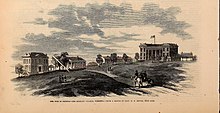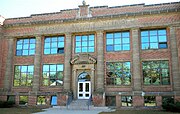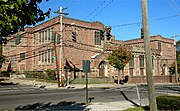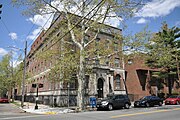User:JPRiley/Brown
| This is not a Wikipedia article: It is an individual user's work-in-progress page, and may be incomplete and/or unreliable. For guidance on developing this draft, see Wikipedia:So you made a userspace draft. Find sources: Google (books · news · scholar · free images · WP refs) · FENS · JSTOR · TWL |
David R. Brown (1831-1910) was an American architect practicing in New Haven, Connecticut.

Life and career[edit]
David Russell Brown was born May 30, 1831 in New Haven to Charles Brown and Lucretia (Russell) Brown. He attended public schools and at the age of sixteen, in 1847, entered the office of Henry Austin, New Haven's leading architect.[1] In the mid-1850s the two briefly formed a partnership, but Brown soon left the partnership and returned to a salaried position. Brown eventually became Austin's chief designer, and has been credited with the design of some of Austin's major projects, including New Haven City Hall (1861-62, NRHP 1975), Rich Hall of Wesleyan University (1866-68) and the mansion of John M. Davies (1867-68).[2] Brown remained with Austin until the late 1860s, when he established his own office.[1] From 1876 to 1883 his partner was Clarence H. Stilson, as Brown & Stilson.
Ferdinand von Beren entered the office of David R. Brown in 1886, also at the age of sixteen. They formed a partnership, Brown & von Beren, in 1895.[3] They remained associated until Brown's retirement in late 1909, at which point Von Beren continued the practice alone, still under the name of Brown & von Beren.
Local historian Elizabeth Mills Brown indicates the former Church of the Redeemer as Brown's most distinctive surviving work.[3] After the formation of the partnership of Brown & von Beren, the firm became increasingly well-known for residential design. Many private homes built during this time have been attributed primarily to von Beren, who continued to make homes a specialty after Brown's retirement and death. Both Brown and von Beren also built extensively for New Haven Public Schools.[3] Many homes by Brown & von Beren survive in the Prospect Hill Historic District.[4]
Personal life[edit]

Brown served in the Civil War, enlisting in the 20th Connecticut Infantry Regiment, which mustered into service September 8, 1862. Initially a Second lieutenant, he was promoted to First lieutenant on March 9, 1863. He was again promoted to the rank of Captain of Company A on April 9, 1864, but was dishonorably discharged on September 8, apparently for desertion.[5] Towards the end of his service, Brown prepared a series of sketches of the Union Army's entrance into Atlanta following the succesful seige, which were published by the Kellogg Brothers of Hartford.[6] Other sketches by Brown during the war were also published.
Circa 1874 Brown moved to West Haven, building a Stick Style home for himself at 35 Peck Avenue. In the 1890s he returned to New Haven,[7] but remained a communicant of Christ Church. It was largely through his influence that noted Gothic architects Cram, Goodhue & Ferguson were selected to design the congregation's new building in 1906.[1]
Brown died February 21, 1910 in New Haven.
Brown's younger brother, George C. A. Brown, was also an architect. He worked for several years with Henry Austin and his son, Fred D. Austin. In 1893 Brown and the younger Austin formed a partnership, practicing as Austin & Brown until 1896.
Architectural works[edit]
- Psi Upsilon Lodge, New Haven, Connecticut (1869-70, demolished)[8]
- Church of the Redeemer (former),[a] New Haven, Connecticut (1870)
- "Edgewood" for Donald Grant Mitchell,[b] Westville, Connecticut (c.1870)[3]
- Dwight Place Congregational Church (former),[c] New Haven, Connecticut (1871)[3]
- 552-562 Chapel Street townhouses, New Haven, Connecticut (1871)[3]
- New Haven County Courthouse (former), New Haven, Connecticut (1871, NRHP 1975, demolished)[3]
- Gatehouse of Evergreen Cemetery, New Haven, Connecticut (1872, demolished)[3]
- First Congregational Church, Waterbury, Connecticut (1873, demolished)[9]
- Most Holy Trinity R. C. Church, Wallingford, Connecticut (1875-87)[10]
- Joseph Parker Building, New Haven, Connecticut (1875, NRHP 1986)[11]
- St. Michael Episcopal Church, Naugatuck, Connecticut (1875)[12]
- Connecticut Cottage, Centennial International Exposition, Philadelphia, Pennsylvania (1876, demolished)[3]
- House for Goodwin Stoddard, Bridgeport, Connecticut (1877, altered)[13]
- House for Dr. S. C. Powell, Newport, Rhode Island (1878-79)[14]
- House for Max Adler, New Haven, Connecticut (1879)[3]
- House for Alexander Catlin Twining, New Haven, Connecticut (1880)[4]
- New Haven Armory (former), New Haven, Connecticut (1883, demolished)[15]
- Woodward Hall,[d] Connecticut Valley Hospital, Middletown, Connecticut (1885-87, NRHP 1985, demolished 2007)[16][17]
- House for Charles L. Jarvis, Portland, Connecticut (1887)[18]
- Hamden Town Hall, Hamden, Connecticut (1888, demolished 1923)[19]
- House for Samuel Train Dutton, New Haven, Connecticut (1889)[20][21]
- House for Nicholas W. Hubinger,[e] New Haven, Connecticut (1893, demolished)[22]
- West Haven Town Hall, West Haven, Connecticut (1893, demolished)[23]
- Portland Town Hall and Buck Library (former), Portland, Connecticut (1894-96)[24]
- 619-625 Congress Avenue Apartments, New Haven, Connecticut (1897)[3]
- Savings Bank of Ansonia Building, Ansonia, Connecticut (1900)
- House for Samuel A. York, New Haven, Connecticut (1905)[4]
- St. Luke Episcopal Church, New Haven, Connecticut (1905, NRHP 2003)[25]
- "Lucerne" for Frederick Grave,[f] Hamden, Connecticut (1906)[3]
- House for C. O. Requa, Cold Spring Harbor, New York (1907)[26]
Projects executed by Brown & von Beren following Brown's retirement and death include:
- House for Frederick M. Adler, New Haven, Connecticut (1910)[4]
- "Villa Rosa" for Sylvester Z. Poli, Woodmont, Connecticut (1910)[27]
- Clinton Avenue School, Fair Haven, Connecticut (1911)[3]
- House for Ferdinand von Beren,[g] Westville, Connecticut (1913)[3]
- Johnson Building, New Haven, Connecticut (1914)[3]
- House for Maud Hughes, West Haven, Connecticut (1915)[28]
- House for Frank B. Waite, Worcester, Massachusetts (1915)[29][30]
- Strong School, Fair Haven, Connecticut (1915)[3]
- New Haven Jewish Home for the Aged, New Haven, Connecticut (1921-23, NRHP 1979)[31]
- El Dorado Apartments, New Haven, Connecticut (1922)[3]
- Spireworth School (former), New Haven, Connecticut (1925)[3]
- Emanuel Lutheran Church, New Haven, Connecticut (1927)[3]
- Helen Street School, Hamden, Connecticut (1927, demolished)[32]
- Fair Haven Junior High School, Fair Haven, Connecticut (1928)[3]
- House for Sylvester Z. Poli, New Haven, Connecticut (1929)[3]
- House for Leslie H. Jockmus, New Haven, Connecticut (1935)[3]
- Shelton High School (former), Shelton, Connecticut (1953)[33]
Gallery of architectural works[edit]
-
Psi Upsilon Lodge, New Haven, Connecticut, 1869-70.
-
House for Max Adler, New Haven, Connecticut, 1879.
-
House for Alexander Catlin Twining, New Haven, Connecticut, 1880.
-
Woodward Hall, Connecticut Valley Hospital, Middletown, Connecticut, 1885-87.
-
Hamden Town Hall, Hamden, Connecticut, 1888.
-
House for Frederick M. Adler, New Haven, Connecticut, 1910.
-
Clinton Avenue School, Fair Haven, Connecticut, 1911.
-
Strong School, Fair Haven, Connecticut, 1915.
Notes[edit]
- ^ Home to Trinity Lutheran Church since 1916.
- ^ Though the estate has been subdivided, Edgewood house still stands at 1076 Forest Road.
- ^ Now (2021) home to St. Paul's U. A. M. E. Church.
- ^ Construction was supervised by architect Jasper D. Sibley of Middletown.
- ^ Formerly located at 600 Whalley Avenue. One of the most expensive houses built in New Haven at the time.
- ^ In 1961 this house became home to the architectural firm of Eero Saarinen, and was occupied by his sucessors, Roche-Dinkeloo, until 2019.
- ^ Von Beren's own Arts and Crafts-inspired home, located at 116 McKinley Avenue in Westville.
References[edit]
- ^ a b c https://archive.org/details/newhavenbookreco00seym/page/250/mode/2up?q=Austin
- ^ James F. O'Gorman, Henry Austin: In Every Variety of Architectural Style (Middletown: Wesleyan University Press, 2008)
- ^ a b c d e f g h i j k l m n o p q r s t u v Elizabeth Mills Brown, New Haven: A Guide to Architecture and Urban Design (New Haven: Yale University Press, 1976)
- ^ a b c d Prospect Hill Historic District NRHP Registration Form (1979)
- ^ Record of Service of Connecticut Men in the Army and Navy of the United States During the War of the Rebellion (Hartford: State of Connecticut, 1889)
- ^ Nancy Finlay, "From Hartford to Everywhere: The History of the Kellogg Firm and Its Associates" in Picturing Victorian America: Prints by the Kellogg Brothers of Hartford, Connecticut, 1830-1880, ed. Nancy Finlay (Hartford: Connecticut Historical Society, 2009): 11-25.
- ^ New Haven directories
- ^ Lyman Hotchkiss Bagg, Four Years at Yale (New Haven: Charles C. Chatfield & Company, 1871)
- ^ "State News" in Connecticut Western News, February 21 1873, 2.
- ^ "Building Intelligence," American Architect and Building News 7, no. 224 (April 10 1880): 159.
- ^ Imperial Granum-Joseph Parker Buildings NRHP Registration Form (1986)
- ^ http://historicbuildingsct.com/st-michaels-episcopal-church-naugatuck-1875/
- ^ Sterling Hill Historic District NRHP Registration Form (1992)
- ^ James L. Yarnall, Newport Through its Architecture (Hanover: University Press of New England, 2005)
- ^ "The Connecticut Militia," Frank Leslie's Illustrated Newspaper 56, no. 1436 (March 31 1883): 95.
- ^ [Twentieth Report of the Board of Trustees of the Connecticut Hospital for the Insane for the State of Connecticut (Hartford: State of Connecticut, 1885)
- ^ Connecticut General Hospital for the Insane NRHP Registration Form (1985)
- ^ http://historicbuildingsct.com/the-charles-jarvis-house-1887/
- ^ Dave Johnson, "Hamden's First Town Hall," Hamden Historic Society.
- ^ "A Cottage at New Haven, Conn." in Scientific American, Architects and Builders Edition 11, no. 4 (April 1891): 52.
- ^ "Building Notes" in New Haven Daily Morning Courier and Journal, December 11 1889, 4.
- ^ "Building Intelligence" in Engineering Record 27, no. 7 (January 14 1893): 147.
- ^ "West Haven Matters" in New Haven Daily Morning Courier and Journal, February 1 1893, 2.
- ^ http://historicbuildingsct.com/buck-foreman-community-center-portland-1852/
- ^ St. Luke's Episcopal Church NRHP Registration Form (2003)
- ^ Main Street Historic District NRHP Registration Form (1985)
- ^ https://www.google.com/books/edition/Modern_Connecticut_Homes_and_Homecrafts/pkhIAAAAYAAJ?hl=en&gbpv=0
- ^ West Haven Green Historic District NRHP Registration Form (2000)
- ^ "WOR.223." mhc-macris.net. Massachusetts Historical Commission, n. d. Accessed December 9 2021.
- ^ Advertisement for Sandusky Portland Cement Company in House Beautiful 40, no. 2 (July 1916): 108.
- ^ New Haven Jewish Home for the Aged NRHP Registration Form (1979)
- ^ "Construction News," Engineering News-Record 98, no. 26 (January 6 1927): 113.
- ^ "Construction Reports," Engineering News-Record 150, no. 6 (February 5 1953): 119.












